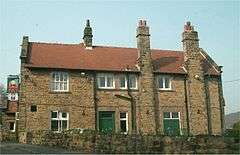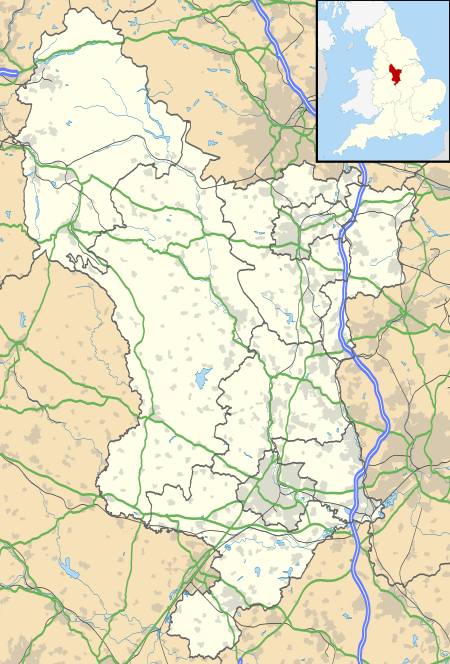Grindleford
Grindleford is a village and civil parish in the county of Derbyshire, in the East Midlands of England. The population of the civil parish as taken at the 2011 Census was 909.[1] It lies at an altitude of 492 feet (150 m) in the valley of the River Derwent in the Peak District National Park. On the west side of the valley is the 1,407 feet (429 m) high Sir William Hill, and to the south-east lies the gritstone escarpment of Froggatt Edge. Grindleford became a parish in 1987, merging the parishes of Eyam Woodlands, Stoke, Nether Padley and Upper Padley.
| Grindleford | |
|---|---|
 Sir William Hotel | |
 Grindleford Location within Derbyshire | |
| Population | 909 (2011) |
| Civil parish |
|
| District | |
| Shire county | |
| Region | |
| Country | England |
| Sovereign state | United Kingdom |
| Post town | HOPE VALLEY |
| Postcode district | S32 |
| Dialling code | 01433 |
| Police | Derbyshire |
| Fire | Derbyshire |
| Ambulance | East Midlands |
| UK Parliament | |
The nearest city to Grindleford is Sheffield, the centre of which is about 7 miles (11 km) away. For rail travellers, the Sheffield suburb of Totley is less than three miles away at the other end of the Totley Tunnel, the second-longest rail tunnel in the UK. Grindleford railway station (actually located in Upper Padley, half a mile away from the village) is at the western portal of the rail tunnel, on the scenic Hope Valley Line between Sheffield and Manchester.
Grindleford is popular with walkers and climbers due to its proximity to a variety of landscapes, including open moorland, wooded river valleys (including Padley Gorge), several gritstone escarpments, and the broad Hope Valley. Visitors seeking refreshment are well catered for by a number of establishments, including the Sir William Hotel, the Maynard Hotel and Bar, the National Trust Longshaw Estate Visitor Centre, and Grindleford Station Cafe (in the old station house).
Education
The village has one school, Grindleford Primary School.[2] It was rated as "good" in its March 2018 Ofsted report.[3]
Hope Valley College runs a course in Painting and Drawing at Grindleford Pavilion.[4]
Padley Chapel

Padley Hall (or Padley Manor) was a large double courtyard house where, in 1588, two Catholic priests (Nicholas Garlick and Robert Ludlum) were discovered and then, two weeks later, hanged, drawn and quartered in Derby. They became known as the 'Padley Martyrs'. Padley Hall today is mostly in ruins, although part of it—probably originally the central gatehouse range—survives, and in 1933 was converted to a Roman Catholic chapel in honour of the martyrs.[5] The chapel, a Grade I listed building,[6] stands not far from the railway line.
References
- "Civil Parish population 2011". Neighbourhood Statistics. Office for National Statistics. Retrieved 25 March 2016.
- "Grindleford Primary School". Grindleford Primary School. Retrieved 8 August 2018.
- enquiries@ofsted.gov.uk, Ofsted Communications Team. (5 November 2010). "Find an inspection report". reports.ofsted.gov.uk. Retrieved 8 August 2018.
- "Adult & Community Education". Hope Valley College. 27 July 2016. Archived from the original on 4 August 2018. Retrieved 8 August 2018.
- Redfern, R., Portrait of the Hope Valley, The Cottage Press, 1988, p11
- Historic England. "Padley Chapel (Grade I) (1335033)". National Heritage List for England. Retrieved 25 November 2012.
External links
| Wikimedia Commons has media related to Grindleford. |